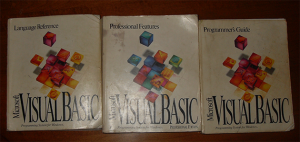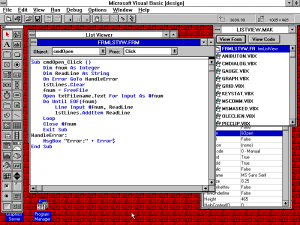This is part of a series on some historic development software.
Currently there is content written for Visual Basic 1.0,Visual Basic 2.0,Visual Basic 3.0, and Visual Basic 4.
With the runaway success of Visual Basic 1.0, it made sense for future versions to be released improving incrementally on the existing version. Such was how we ended up with Visual Basic 2.0. In some ways, Visual Basic 2.0 changed Visual Basic from a backwater project like Microsoft Multiplan into something that would become a development focus for years to come- like Microsoft Excel.
Visual Basic 2.0 was quite a leap forward; it improved language features, the IDE, and numerous other things. One of the biggest changes was the introduction of the “Variant” Data type. A full list of new features, from the Visual Basic 2.0 Programmers Guide, with annotations on each by me.
- Improved Form design tools, including a toolbar and a Properties Window
Visual Basic 2.0 adds the ability to select multiple controls by dragging a box around them. It also adds a Toolbar, which replaces the area used by the Property modification controls in Visual Basic 1.0. The new Properties Window moves the Property Editing to a separate Window, which is a massive improvement since you can more easily inspect properties.
- Multiple-Document interface Support
Another rather big feature. MDI was and is the capability that allows a Window to have it’s own Child Windows. This has started to fall out of vogue and is all but forgotten. Earlier Office versions provided an MDI interface. The core of MDI was basically set by Program Manager itself, which was a MDI Application. Visual Basic 2.0 allows you to create MDI Forms, and MDI Applications. This is provided through a few Properties. I will cover MDI stuff that VB2.0 adds later in this Post.
- New Properties, Events, and Methods
Visual Basic 2.0 added several Properties, Events, and Methods to the available controls. It changes the “CtlName” of all Controls to the less stupid “Name”, and added multiple new Events, particularly surrounding Drag and Drop capabilities.
- Object Variables and Multiple Form instances
This is a pretty major shift. For one thing, it established Forms not as their own, distinct objects (as was the case in VB1.0) but rather as their own Class of Object. You were also capable of creating new form instances, inspect Object Types, and various other Object-Oriented capabilities. it was still relatively limited, but it was certainly a step forward and it added a wealth of capability to the language.
- Variant Data Type
This is another Big one. Visual Basic 1.0 had a number of Data Types, as you would expect; Integer, a 16-bit Integer value, Long, a 32-bit Integer value, Single, a 16-bit floating point value, Double, a 32-bit floating point value, Currency, a Scaled Integer value, and String. Visual Basic 2.0 shakes things up by not only adding Forms as their own ‘Data Type’ of sorts, but it also adds Variant, which is basically a Value that can represent anything.
Variants are an interesting topic because while they originally appeared in Visual Basic 2.0, they would eventually seep into the OLE libraries. As we move through the Visual Basic versions, we will see a rather distinct change in the Language, as well as the IDE software itself to reflect the changing buttresses of the featureset. One of the additional changes to Visual Basic 2.0 was “Implicit” declaration. Variables that hadn’t been referred to previously would be automatically declared; This had good and bad points, of course- since a misspelling could suddenly become extremely difficult to track down. It also added the ability to specify “Option Explicit” at the top of Modules and Forms, which required the use of explicit declarations. Visual Basic 1.0 also allowed for implicit declarations, but you needed to use some of the ancient BASIC incantations (DefInt, DefLng, DefSng, DefDbl, and DefCur) to set default data types for a range of characters. It was confusing and weird, to say the least.
- Shape,Line, and Image controls
The Shape, Line, and Image controls added to VB2 are a new feature known as “windowless” controls, in that they do not actually use a Window handle. One of the larger benefits from this was that the controls were lightweight; the second was that they could be used for simple graphics on a VB2 Form.
- Grid Custom Control
Visual Basic 2.0 comes with a Grid Custom Control. I swear this thing has what feels like an entire chapter devoted to it in the Programmers guide. I’m not even Joking- “Chapter 13: Using the Grid Control”. The Grid control is rather awkward to use for those more accustomed to modern programmatic approaches and better designed control interfaces.
- Object Linking & Embedding Custom Control
OLE (pronounced “O-Lay” I was pronouncing it as Oh-Ell-Eee for the longest time and don’t think I’ll ever live down the embarassment. The basic idea was to allow one application to be “embedded” inside another. functionality- to the user- it would simply look like inserting a document, which was part of the purpose. For example, you can insert an Excel spreadsheet inside a Word document and then edit that Excel Spreadsheet- from within Word- as if it was Excel. What happened? Well it was bloody confusing. While it was (and still is) a very powerful feature, it was far from intuitive and was something far more likely to be used by power users.
- Added Debugging Features, including Watch variables and a Calls Window.
It’s amazing the stuff we did without in older Programming environments, isn’t it? Visual Basic 1.0 provided very simplistic Debugging support. This was not uncommon among the IDE tools of the time. Visual Basic 2.0 added some debugging helpers and in some ways added a new “mode” to the Program; Immediate Mode. Visual Basic 1.0 had similar capabilities, in that it did have something of an “immediate” mode; particularly shown by the Immediate Window. However, Visual Basic 1.0’s implementation was far simpler, and it didn’t support Watch Variables, which is one of the primary new features added in VB 2.0. This paired with with the Toolbar controls that almost emulate “playback” of the application gave rise to the idea of Three Modes; The first, you write code and design forms. The second is where you run the application, and the third. Immediate Mode, is when you are debugging; eg. Your application is Stopped but you can inspect it’s running state.
- ASCII representation of Forms
As far as I’m concerned, this is the single best feature added to Visual Basic 2.0. Historically, many applications- including things like Visual Basic as well as other Language interpreters or editors, saved their source in a proprietary, binary format. This was done not so much to protect it, but for space-saving reasons. When you only have a 160K disk, a difference of a single Kilobyte can be important. Additionally, for text formats it takes longer to load and save (at least with the paltry memory and processing power of the time in comparison to today). Visual Basic 1.0 as well as it’s QuickBASIC predecessor allowed for saving files as text, but this was not the default option. Visual Basic 2.0 adds the ability to save not only source code- as the Visual Basic 1.0 Code->Save Text Option did- but also to save the Form design in a text format. this was a massively useful feature since it allowed external tools to manipulate the form design as well as the code, as well as making your software development less dependent on an undocumented format.
- 256-Color support for bitmaps and color palettes.
Back in those days, Colour was a trade-off. Video Adapters usually had limited Video Memory, so you usually had a trade-off between either higher resolution and fewer colours, or lower resolution and more colours. Today, this isn’t an issue at all- 32-bit and 24-bit Colour has been the standard for nearly two decades. As this was developing, however, we had the curious instance of 256-colour formats.
256-colour modes uses a single byte to index each colour, and palette entries are stored separately. The index them becomes a lookup into that table. This had some interesting effects; Applications could swap about the colours in their palette and create animations without really doing anything; the Video Adapter would simply change mappings itself. This was a very useful feature for DOS applications and Games.
Windows, however, complicated things. Because Windows could run and display the images from several Applications simultaneously, 256-color support was something of a tricky subject. Windows itself reserved it’s own special colours for things like the various element colours, but aside from that 8-bit colour modes depended on realized palettes. What this means is that Applications would tell windows what colours they wanted, and Windows would do what it could to accomodate them. The Foreground application naturally took precedence, and in general when an application that supported 8-bit colour got the focus, it would say “OK, cool… realize my palette now so this owl doesn’t look like somebody vomited on an Oil Painting”. With Visual Basic 1.0, this feature was not available for numerous reasons, most reasonable among them being a combination of it just not being very important paired with the fact that VB was designed primarily as a “front end” glue application for other pieces of code. Visual Basic 2.0 however adds 256-color support. This adds quite a few properties and methods that are used. VB itself manages the Palette-relevant Windows Messages, which was one of the reasons VB 1.0 couldn’t even be forced to support it.

The Three Visual Basic 2.0 Manuals in their native environment of a random Wooden Table. The “Professional Features” guide is about twice as thick as the other two. Note the use of the old cover style that was typical of MS Documentation of the time.
As we can see above, Visual Basic 2.0 adds Syntax highlighting over VB1; an additional side effect of this is that the colours can also be customized. I recall I was a fan of using a green background and yellow text for comments to make them stand out, myself.
On a personal Note, Visual Basic 2.0 is dear to me (well, as dear as a software product can be), since it was the first Programming Language I learned and became competent with to the point where I realized that I might have a future with software development. Arguably, that future is now, but it hasn’t actually become sustainable (I may have to relocate). But more so than this is the fact that I was given a full, legal copy of the software. This in itself isn’t exceptional, but what is is the fact that it had all the manuals:
Dog-eared, ragged, and well-used, these books- primarily the Programmers Guide and Language Reference- became the subject of meticulous study for me.
Have something to say about this post? Comment!


One thought on “History of Development: Visual Basic 2.0”
Hi there outstanding website! Does running a blog such as
this take a massive amount work? I have very little expertise in coding however I had been hoping to start my own blog soon.
Anyways, should you have any ideas or techniques for new blog owners please share.
I understand this is off subject however I simply needed
to ask. Cheers!